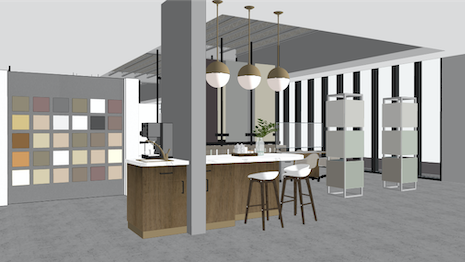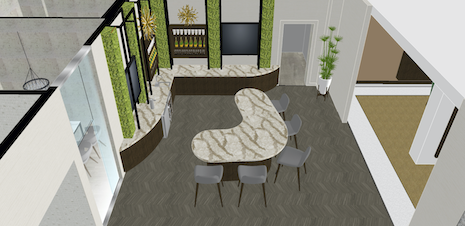 Retailers will have to create a "third place" within stores for customers to interact safely and comfortably with associates. Image courtesy of JGA
Retailers will have to create a "third place" within stores for customers to interact safely and comfortably with associates. Image courtesy of JGA
By Ken Nisch
No matter what industry you are in, COVID-19 is having an impact on your business. You have already had to adapt quickly – whether it is taking the steps to make your space cleaner and safer, or ramping up technology or other shopping mechanisms to address customer concerns and keep commerce moving as much as possible.
Now, it is time to prepare for longer-term implications.
One chance
No economist could have predicted a year ago we would be where we are today.
Retail has had its share of ebbs and flows, always recovering and evolving. This is more than a hiccup.
This wave of disruption has caused critical shifts in behaviors that will be here to stay for quite some time.
Operating hours are shorter and in-person visits are shorter, more focused and quite different than there were six months ago.
Consumers are going to stores less and making more conscious, calculated decisions about where they shop and what they buy.
Now, you have only one chance to get the customer experience right.
Customers’ terms
Many customers are eager to get back to shopping. However, the shopping they are craving goes beyond the transaction. It entails a personal connection between the brand and the consumer.
The difference is, customers – not brands – are now driving what that connection means. It is up to retailers to exceed those expectations.
Retailers will have to accommodate not only safety concerns, but also a shift in the way that customers want to interact.
For non-essentials, this includes building store hours around customer convenience instead of forcing their hours on shoppers.
It might mean companies will have to take one-on-one appointments outside of traditional operating hours. They will have to adjust to flexible selling, accommodating customers who want to transact in-person and those who prefer a virtual option. It requires more planning for more engagement with associates.
Luxury and specialty goods stores will need to become both a showroom and a sample space where both experiences are more curated for each individual.
Where coffee bars and complimentary pastries were once a nice way to make customers feel welcome and relaxed, retailers will have to find new, more bespoke ways to create hospitality. They will also need to convey that “We’re glad you’re here,” so that consumers do not feel like a burden.
Customers might not want to walk around the entire store nor meet in an enclosed office.
 The next generation of in-store hospitality should be thoughtfully done with the right lighting, technology and atmosphere to be fluid and configurable. Image courtesy of JGA
The next generation of in-store hospitality should be thoughtfully done with the right lighting, technology and atmosphere to be fluid and configurable. Image courtesy of JGA
Third place
One idea is to build a new platform for unique selling opportunities and engaging one-on-one interactions, a concept that we term broadcast selling. This is a dedicated area of your space where you can host both in-person and online appointments.
This open, neutral ground where the associate and the customer can meet and lay out merchandise becomes the third place. While intentional, it should not appear too formal. Instead, it feels more welcome and personal and, of course, safe.
Just as most of us have moved our offices into our kitchens or dining rooms, this shift in selling becomes more natural and friendly, but also more tailored to the individual.
The concept of the third place is not new.
However, it is even more important now as consumers are looking to connect with brands on their terms. Consumers are craving a respite from their world that has been turned upside down and this is an opportunity for retailers to create that.
When consumers can feel calm in an environment, they are more likely to feel confident in their purchase decisions.
We can also leverage these spaces and tools that were originally hospitality areas and alter them for virtual appointments.
This next generation of hospitality thoughtfully done with the right lighting, technology and atmosphere should be fluid and configurable.
For example, lighting that can be altered for daytime versus nighttime appointments can change the mood.
A backdrop that can be changed based on pre-determined customer criteria has the potential to resonate more.
All elements must be carefully curated, including the highly adept associate.
Associates are the glue to this experience. When they are highly trained in your products or services, as well as your brand, they have the ability to become your key differentiator.
This new idea of hospitality means equipping your best salespeople with the relevant tools to sell in today’s market.
FOR YOUR NEW broadcast studio to be successful, it involves the right setting, the right technology and the right salespeople.
In the world we are in today, cultivating that relationship with your customer is just as important as cultivating your bottom line. It is your bottom line.
 JGA chairman Ken Nisch speaking at Luxury Daily's Luxury Marketing Forum in 2018
JGA chairman Ken Nisch speaking at Luxury Daily's Luxury Marketing Forum in 2018
Ken Nisch is chairman of JGA Branded Environments, Southfield, MI. Reach him at [email protected].
